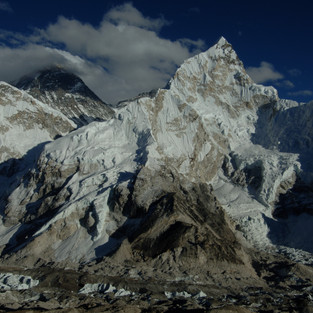Follow us to Everest - Day 8, Lobuche to Gorak Shep & Kala Pattar
- World Adventure Guides

- May 15, 2018
- 3 min read

Prepare yourself for an awesome mountain day.

The walk to Gorak Shep should take around two and a half to three and a half hours. This will take you to an altitude of 5140m. After some lunch and a rest, a round trip of about four and a half hours will take you up to the summit of Kala Pattar and back down.
As you are leaving Lobuche the landscape becomes more lunar-like, with very little vegetation. For the first hour or so the trail runs beside the huge lateral bank of the Khumbu glacier, before reaching an obvious rest point by a giant glacial boulder at the foot of a short, sharp climb.
At the top of the climb you’ll shortly start walking on the jumbled grey landscape surface of the Changri Shar Glacier. It feels and looks solid, but is in fact slowly flowing into the main Khumbu Glacier, which is below you to the right. The breath-taking views from here stretch from the boulder-strewn glacier at your feet, up onto the beautiful, fluted ice-face of Nuptse, and round to the snowed domes of Khumbutse, Lingtren and Pumo Ri – simply stunning.
After more than an hour of walking on this rocky ground you’ll round a corner to the welcome sight of your lunch stop, Gorak Shep, with the last buildings before Everest Base Camp. It nestles on the lateral moraine and on the edge of a flat, sandy bowl.

This is the last settlement at the head of the Khumbu Valley: next stop Everest Base Camp.
The first thing you see when you round the final corner of the day’s trek is a handful of lodges overshadowed by a mobile phone mast powered by a bank of solar panels all regimentally facing to the south. The main reason this has been installed is to serve the needs of increasing number of expeditions that are camped three hours further up the valley in the main climbing season - even at this remote part of the planet the spirit of wildness has been brushed off a bit by the needs of the modern mountaineer and trekker.
To the east of the buildings and up and over the rise in the landscape lies the jumbled grey mass of the Khumbu Glacier. The formation has shrunk due to the effect of climate change in recent years and now sits many metres below the lip of the terminal moraine. It is a great place though for photography, particularly at sunset when the light on the opposite face of Nuptse is simply stunning.
Following a rest and some lunch it’s time to tackle Kala Pattar (which means ‘black rock’). At 5545 metres this is a tough challenge, but a rewarding one for it’s staggering views of the whole of the Upper Khumbu, including the classic image of the black face of Everest rising above the Western Shoulder.

Some people suggest a morning ascent of the peak, but the light is much better in the afternoon, with the sun shining on Everest rather than coming from behind, as it does at sunrise.

Make sure to pack all your warm gear before setting off – hat, large gloves, duvet jacket, windproof trousers, buff – as the top of the peak will feel bitterly cold in even the slightest breeze.
Along the trail you will often hear the phrase ‘bistare’, which means ‘slowly’; it will feel fitting as you toil upwards. The thin air at this altitude will make for hard going and you will feel the need to stop frequently to catch your breath.
You should be at the summit in 2–3 hours................ to take in a view that will live with you forever.
This tough, lung-testing slog to the highest point of the trek at 5545m is rewarded with staggering views of the whole of the upper Khumbu.
A prayer flag on a pole makes an ideal frame to capture the black, triangular face of Everest jutting into the sky between the peak’s western shoulder and the lower slopes of Nuptse. The true high point of Kala Pattar sits behind this pole on a small slab of rock that is easy to climb on to but drops for many hundreds of metres on its far side.
In the ate afternoon the warm light on Everest makes for a fabulous picture. Brave souls endure the rapidly falling temperatures to capture the last rays of the sun lighting up the peak.
Remember to pack a torch for the journey back down.
Back in Gorak Shep, remember that you are now at high altitude so you need to monitor your health carefully, and also that of other members of your group if you are with one. Altitude sickness is potentially fatal. If you have a problem then speak with your guide, or with a lodge owner.
Be safe!
Everest tomorrow........



















Comments